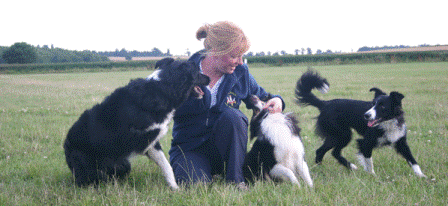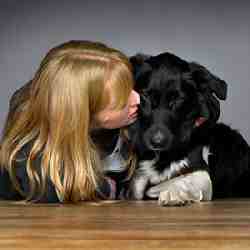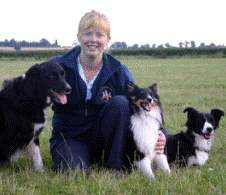| |
Sports medicine and rehabilitation therapy...

Many agility handlers
might have
wondered about the benefits of seeking professional advice on a competition dog that
didn't seem to have any perceivable problems. They might have questioned why Gemma Osmond felt the need
to have Ella checked over at the Smart Clinic when she had competed so successfully that year. It's simple really!
Gemma felt it made sense to consult the experts when it came to the health and well-being of
someone as important as her dog.
|
Dogs
can't tell us if there's a problem and we won't always be able to work it out if it's not
obvious. I know a dog in pain is potentially a dangerous animal through no real fault of
their own. As a mum of two toddlers, it made sense to take Kai and Ella to see the
experts.
Plus, I felt that Ella being
so successful for me last year was reason enough to have her checked over.
I first visited the
Smart Clinic in Cardiff at the beginning of October 2009 with my two collie dogs Kai and
Ella. From my point of view, the visit was mainly for the benefit of my boy Kai who lost
his front right leg in a car accident, aged 18 months old. Ella, my current competition
dog, had done very well that year, so I didn't expect she would require much, if any,
treatment at all.
My first impressions of
Lowri Davies, the vet who runs the Smart Clinic, and her veterinary physiotherapist,
Hannah Price were very positive. I felt that my dogs were in very good hands.
 Kai Kai
We started
the appointment with Kai. Lowri's diagnosis of Kai was more upsetting than I had prepared
myself for as I became aware of the level of pain he was living with on a day-to-day
basis, but even that was balanced with her confidence that the quality of his life could
be dramatically improved. That has indeed proved the case, and I now have a much happier
- and naughtier - collie dog than I had previously!
Ella
Then it was my girls turn in
the spotlight. The first part of the initial assessment involves taking a detailed case history
of the dog including any injuries it might have sustained, any worries the owner might have
etc. The second part involves walking the dog up and down in a straight line and then in
circles to the left and right. This gives an enormous amount of information about how the dog
is currently using their body and what adjustments might need to be made.
In Ella's case, her clinical
history included a fall from a sea wall whilst out walking when she was just six months old
where she had broken her back right leg. At the time, she had seen an orthopaedic specialist to
have the leg plated back together. The plate remains in her leg to this
day. This had never caused her any obvious problems during any part of her agility training, or
dampened her enthusiasm for any of the obstacles.
 I had only worried slightly
about this back leg once during the 2009 competition season, and even at that point it wasn't
an obvious problem that involved her knocking poles or being lame. It was just a feeling that
she wasn't quite right and being Ella she wasn't going to make a fuss or let it get in the way of her agility! I had only worried slightly
about this back leg once during the 2009 competition season, and even at that point it wasn't
an obvious problem that involved her knocking poles or being lame. It was just a feeling that
she wasn't quite right and being Ella she wasn't going to make a fuss or let it get in the way of her agility!
It would be fair to
wonder why I'd bother to have her checked over at all, and in truth, perhaps I wouldn't have
made that visit to Cardiff if it hadn't been for Kai. After all, I had been recommended the
clinic from friends with dogs who had quite serious mobility problems that they'd helped sort
out. Kai clearly fitted into that category, but Ella certainly didn't. It seems that once again
I have reason to thank him, for leading me to meet yet more remarkable people who can better
improve the quality of my dogs lives.
|
Observations
& Treatment Program
 When I first
examined Ella in 2009, she was only ever so slightly lame on her right hind leg when walking –
certainly not lame enough in the conventional sense to take her to the vet. When standing,
Ella appeared uncomfortable and would move her weight around from one leg to another. Further
examination demonstrated significant muscle spasm and pain – on her first day she rated 7 out
of ten on the SMART Clinic pain scale with one being no pain and ten being the very worst. So
despite not showing any significant lameness Ella was a very sore lady indeed. This is often
the case with most poor performance issues or intermittent lameness in our competing dogs.
This is also the best time to start treatment – before a mild lameness becomes a serious
ligament injury or muscle strain. When I first
examined Ella in 2009, she was only ever so slightly lame on her right hind leg when walking –
certainly not lame enough in the conventional sense to take her to the vet. When standing,
Ella appeared uncomfortable and would move her weight around from one leg to another. Further
examination demonstrated significant muscle spasm and pain – on her first day she rated 7 out
of ten on the SMART Clinic pain scale with one being no pain and ten being the very worst. So
despite not showing any significant lameness Ella was a very sore lady indeed. This is often
the case with most poor performance issues or intermittent lameness in our competing dogs.
This is also the best time to start treatment – before a mild lameness becomes a serious
ligament injury or muscle strain.
Ella had
started to alter the way she moved after she fractured her leg and although she had in some
ways made a good recovery there remained very little muscle on her right hind leg. She had
learnt to do with out it in some ways during her agility. This only works for so long however
before pain and discomfort start to affect performance. The other problem with Ella was that
she had become very stiff through her back and chest which meant that she was permanently off
balance when working.
Ella was
treated with a combination of acupuncture, physiotherapy and gait retraining in the
treadmill. Gemma was sent home with a list of very specific exercises to do which she carried
out to the letter. This meant that by her second visit, Ella's pain score had already come
down to 4 and she was moving much better in general. Ella underwent a progressive
rehabilitation regime which has improved her balance and co-ordination and strengthened her
right hind leg. She no longer competes in pain, and her will to win is stronger than ever.
Lowri Davies
|
It was Kai who started
me on my long held line of thinking that there are experts in every walk of life, and it makes
sense to consult them when it's about the health and well-being of someone as important as your
dog. Unless there's something blindingly obvious like Kai's missing leg, they can't tell us if
there's a problem and we won't always be able to work it out if it's not obvious. I
particularly owe it to my dogs to make sure they're comfortable as I'm also a mum to two
toddlers and they occasionally have to suffer a small child bumping or landing on them. A dog
in pain is a potentially dangerous animal, through no real fault of it's own.
Plus, I felt that Ella
being so successful for me last year was reason enough to have her checked over. She has always
worked her socks off for me. The Easter weekend
is a classic example. Over the Easter Bank Holiday weekend we competed for three days at Kernow
K9 show, and in all the wind and rain Cornwall had to offer. Believe me, it was extreme! Ella
was her usual fantastic self, now well muscled, more powerful and even faster than before.
Now as a result
of the large number of runs, running in those slippery conditions, and probably never
really getting properly dry and warm over the weekend, Ella was found to be very stiff
and sore at our following visit. Some treatment has made her more comfortable and I went
to our next show knowing she was fit and well.
Personally speaking,
I know I
feel myself to be a better handler for having had her checked over. And it's only fair to
Ella. She is the better half of our agility team, and more than deserves the best, not
least because she never gives me anything less than that herself.
The SMART Veterinary Clinic
Founded in 2004. it
was the first specialist referral veterinary rehabilitation centre in the UK. Through the
development of individually tailored programmes it has succeeded not only in helping
numerous dogs return to full athletic activity but also has improved the quality of life
of countless pets through better pain management and a proper exercise regime.
Whether your dog is recovering from surgery, overweight or simply getting
older at the SMART CLINIC they will design a complete management programme to suit your needs. Equally if your dog is an athlete and not performing as well as he or she
should then a detailed assessment at the clinic may well be able to pinpoint the problem and
develop a treatment plan.
All appointments are by veterinary referral. For more information about
treatment and courses, visit
http://www.smartvetwales.co.uk/index.html
 About the author... About the author...
Gemma Osmond
shares her home in Yatton, Bristol with her husband Mike, sons Jamie and Callum and dogs Kai
(WSD), Ella (BC) and Diva (Shetland Sheepdog). Ella is her current competition dog who made the
leap from Grade 1 to Grade 5 in 2009 and won into Grade 6 at her first Kennel Club show of the 2010 season.
Gemma
has been doing agility for about seven years. She, is an Agility Club Approved Instructor -
First Class, and has recently passed the exams to become an agility judge. She also runs her
own dog training and pet care business in her spare time. For more information go to
www.daybreakdogs.co.uk
She
is a full-time mother.
| |
|